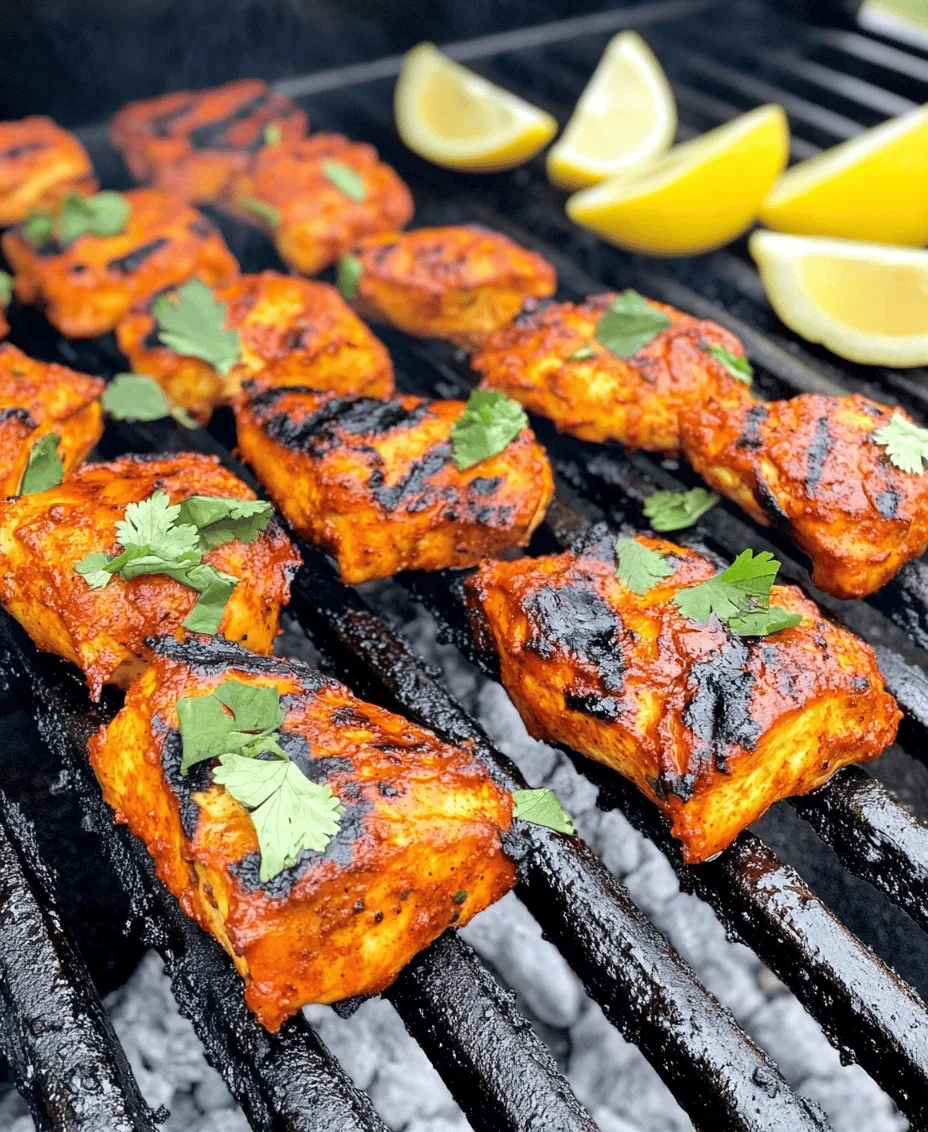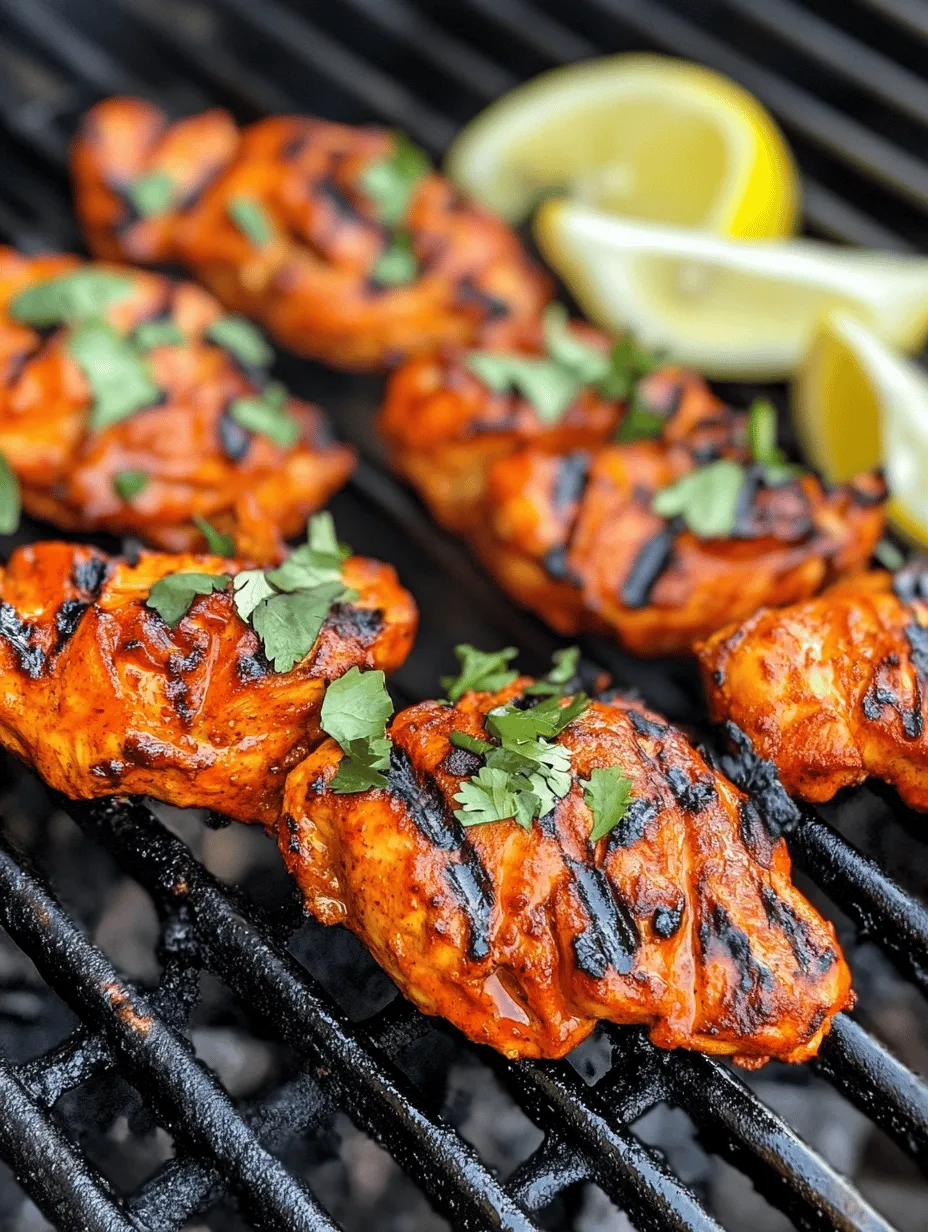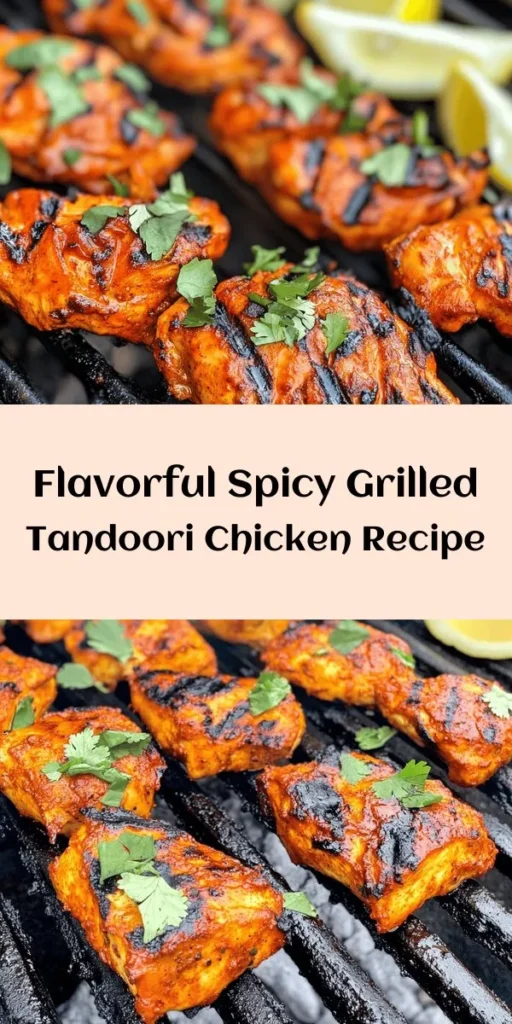Introduction
Tandoori Chicken is an iconic dish in Indian cuisine, known for its vibrant color, smoky flavor, and tender texture. Originating from the northern regions of India, this dish has transcended cultural boundaries, becoming a beloved staple in households and restaurants worldwide. The traditional preparation involves marinating chicken in a blend of yogurt and spices, which not only infuses the meat with rich flavors but also ensures its tenderness. The chicken is then cooked in a tandoor—a clay oven that imparts a unique char and smokiness. However, with the advent of grilling techniques, enjoying this delectable dish at home has become more accessible than ever.
The essence of Tandoori Chicken lies in its complex flavor profile. The marinade typically includes a mix of spices like cumin, coriander, and garam masala, combined with tangy yogurt that complements the spiciness of the paprika or chili powder. This fusion of flavors creates a mouthwatering experience that is both satisfying and aromatic. In this article, we aim to provide a comprehensive recipe for Spicy Grilled Tandoori Chicken, emphasizing its ease of preparation without compromising on taste. Whether you’re hosting a barbecue or simply craving a flavorful meal, this recipe will guide you through each step to achieve the perfect grilled chicken.
Understanding Tandoori Cooking
Tandoori cooking is a traditional method that dates back centuries, rooted in the culinary practices of the Indian subcontinent. The tandoor itself is a cylindrical clay oven that is heated using charcoal or wood, reaching high temperatures that can exceed 900°F (482°C). This method of cooking not only cooks the meat quickly but also seals in the juices, resulting in succulent, flavorful dishes. The intense heat of the tandoor creates a unique char on the meat, which is a hallmark of authentic Tandoori Chicken.
While grilling and tandoori cooking share similarities, there are distinct differences between the two methods. Grilling typically involves cooking over direct heat on a grill surface, which may not reach the same temperatures as a tandoor. However, grilling can still replicate some of the flavors associated with tandoori cooking, especially when using marinades that infuse the meat with spices and moisture. The primary goal remains the same: to achieve a crispy, flavorful exterior while keeping the inside tender and juicy.
A crucial aspect of both tandoori cooking and grilling is marination. The marination process allows the spices and yogurt to penetrate the meat, enhancing its flavor and tenderness. The longer the chicken marinates, the more pronounced the flavors become, making this step vital for a delicious result.
Key Ingredients of Spicy Grilled Tandoori Chicken
The foundation of a great Spicy Grilled Tandoori Chicken recipe lies in its ingredients. Below is an overview of the essential components that contribute to the dish’s distinctive taste:
1. Chicken: When selecting chicken for Tandoori, you have the option of using a whole chicken or cut pieces such as thighs, drumsticks, or breasts. Bone-in pieces are preferred, as they tend to remain juicier during cooking. A whole chicken can be spatchcocked for even cooking and better flavor absorption.
2. Yogurt: This is a key ingredient in the marinade, providing both flavor and moisture. The lactic acid in yogurt tenderizes the chicken, resulting in a melt-in-your-mouth texture. It also acts as a binding agent for the spices, ensuring an even coating.
3. Spices: The spice blend is the heart and soul of Tandoori Chicken. Common spices include:
– Tandoori Masala: A pre-mixed spice blend that can be found in stores or made at home, typically containing coriander, cumin, paprika, and various other spices.
– Garam Masala: A warm spice mixture that adds depth to the marinade.
– Turmeric: This spice not only gives a vibrant yellow color but also adds an earthy flavor.
– Chili Powder: Adjusts the heat level; Kashmiri chili powder is often used for its color and mild heat.
4. Lemon Juice: Fresh lemon juice adds a zesty brightness that balances the richness of the yogurt and enhances the overall flavor.
5. Garlic and Ginger: Freshly minced garlic and ginger contribute a pungent aroma and flavor, elevating the dish to new heights.
The careful selection and combination of these ingredients are what make Spicy Grilled Tandoori Chicken a standout dish. Each element plays a role in creating a harmonious blend of flavors that is both authentic and appealing.
Preparing the Marinade
Creating the perfect marinade for Spicy Grilled Tandoori Chicken is essential for achieving the desired flavor and tenderness. Follow these steps to prepare a delicious marinade:
1. Gather Ingredients: Start by assembling your key ingredients: plain yogurt, tandoori masala, garam masala, turmeric, chili powder, lemon juice, minced garlic, and minced ginger.
2. Mix Dry Spices: In a mixing bowl, combine the tandoori masala, garam masala, turmeric, and chili powder. Adjust the quantities based on your spice preference, keeping in mind that different chili powders have varying heat levels.
3. Combine with Yogurt: Add the plain yogurt to the bowl with the spices. Mix well until the spices are fully incorporated into the yogurt, forming a thick paste. The yogurt should have a smooth consistency, allowing it to coat the chicken evenly.
4. Add Acid: Squeeze in fresh lemon juice, and mix again. The acidity of the lemon juice will help tenderize the chicken further and add a fresh flavor.
5. Incorporate Garlic and Ginger: Finally, fold in the minced garlic and ginger. Their sharpness will complement the spices, adding depth to the marinade.
6. Adjust Consistency: If the marinade seems too thick, you can add a tablespoon or two of water to achieve the desired consistency. The goal is to have a mixture that is thick enough to adhere to the chicken but not so thick that it won’t coat the meat evenly.
7. Taste Test: Before marinating the chicken, taste a small amount of the marinade. If you’d like more heat, add additional chili powder; for more tanginess, consider adding more lemon juice.
By following these steps, you’ll create a flavorful marinade that will penetrate the chicken, ensuring a delightful taste with each bite.
Marinating the Chicken
Marination is the process that sets Tandoori Chicken apart from ordinary grilled chicken. It is crucial for flavor absorption and achieving the desired tenderness. Here’s how to effectively marinate your chicken:
1. Prepare the Chicken: If using whole chicken, spatchcock it by removing the backbone. This allows for even cooking. If using cut pieces, make shallow slashes in the meat to help the marinade penetrate deeper.
2. Coat the Chicken: Place the chicken in a large bowl or zip-top bag. Pour the prepared marinade over the chicken, ensuring every piece is well-coated. Use your hands to massage the marinade into the meat, making sure it gets into the slashes and crevices.
3. Seal and Refrigerate: If using a bowl, cover it tightly with plastic wrap; if using a bag, seal it securely. Refrigerate the marinated chicken for a minimum of 4 hours, but ideally overnight. The longer the chicken marinates, the more intense the flavors will be.
4. Best Practices: Ensure that the chicken is covered completely during the marination process to prevent any contamination and to keep the meat moist. If marinating overnight, consider flipping the chicken halfway through to ensure even flavor distribution.
5. Bring to Room Temperature: Before grilling, allow the marinated chicken to sit at room temperature for about 30 minutes. This step ensures even cooking and helps to achieve that perfect char on the grill.
By following these marination guidelines, you’ll allow the flavors to meld beautifully, resulting in a mouthwatering Spicy Grilled Tandoori Chicken that is bursting with flavor.
As we continue in this article, we will explore the best grilling techniques to achieve that authentic tandoori flavor, ensuring that your homemade Spicy Grilled Tandoori Chicken is as delicious as it is easy to prepare. Stay tuned for the next steps that will elevate your grilling game!

Pre-Grilling Preparations
Before you fire up the grill for your Spicy Grilled Tandoori Chicken, there are a few essential preparations to ensure your chicken turns out perfectly juicy and packed with flavor. Start by preheating your grill to a medium-high heat, which is about 375°F to 400°F (190°C to 200°C). This temperature range is ideal for achieving the perfect char on the outside while keeping the meat tender and juicy on the inside.
Next, it’s time to prepare your marinated chicken. If you’ve used a whole chicken, cut it into quarters for even cooking. For chicken pieces like thighs, drumsticks, or breasts, ensure they are evenly coated with the marinade. Allow the chicken to sit at room temperature for about 15 to 20 minutes before grilling. This step not only helps in cooking the chicken evenly but also allows the flavors to penetrate the meat further.
Detailed Instructions for Grilling the Chicken
Once your grill is preheated and the chicken is ready, it’s time to get grilling. Place the chicken pieces bone-side down on the grill grates, ensuring they are not overcrowded. This allows for even cooking and prevents steaming. Close the grill lid to retain heat and ensure the chicken cooks through.
Grill the chicken for about 5 to 7 minutes on the first side. When the chicken releases easily from the grill and has nice grill marks, it’s time to turn it over. Cook on the second side for another 5 to 7 minutes. If you’re using larger pieces, you may need to adjust the cooking time accordingly.
Time Management During Grilling: Cooking Times for Different Chicken Sizes
For smaller pieces like wings, grilling time will be about 15-20 minutes total, while for larger cuts, such as bone-in chicken breasts or whole quarters, expect to grill them for 25-30 minutes. Always check the chicken for doneness rather than relying solely on time.
Checking for Doneness
Ensuring that your chicken is cooked to the right internal temperature is crucial for both safety and quality. The USDA recommends that chicken should reach an internal temperature of 165°F (75°C). To accurately check the temperature, insert a meat thermometer into the thickest part of the chicken, avoiding bone.
In addition to using a thermometer, there are visual cues that indicate your chicken is properly cooked. The juices should run clear, and the meat should no longer be pink near the bone. The skin should be crispy and slightly charred, giving it that signature tandoori look.
Resting and Serving the Chicken
After grilling, allow the chicken to rest for about 5 to 10 minutes before serving. Resting is crucial because it allows the juices to redistribute throughout the meat, resulting in a more flavorful and juicy bite.
When it’s time to serve, garnish your Spicy Grilled Tandoori Chicken with freshly chopped cilantro for a vibrant touch. You can also add a squeeze of lime or lemon for an extra zing.
Pairing Ideas: What to Serve with Tandoori Chicken
Tandoori Chicken is versatile and pairs beautifully with various sides. Traditional accompaniments include warm naan bread, fragrant basmati rice, or a refreshing cucumber raita. You can also serve it with tangy chutneys, such as mint or tamarind, which enhance the flavors of the dish. Consider a side of grilled vegetables or a fresh salad to complete the meal.
Nutritional Benefits of Tandoori Chicken
Tandoori Chicken not only tantalizes the taste buds but also offers a range of nutritional benefits. The primary ingredient, chicken, is a great source of lean protein, essential for muscle growth and repair.
The yogurt used in the marinade adds probiotics, which are beneficial for gut health, while the spices—such as turmeric, cumin, and coriander—provide antioxidants and anti-inflammatory properties.
Grilling versus frying is also a significant health aspect. Grilled chicken retains less fat compared to fried options, making it a healthier choice. By opting for grilling, you’re not only reducing caloric intake but also enhancing the flavor profile of the chicken through the smoky char.
Cultural Variations and Adaptations
Tandoori Chicken has its roots in the Indian subcontinent, where regional variations abound. In northern India, for instance, the chicken is often marinated with various spices and yogurt, while southern regions might incorporate coconut and curry leaves into their version.
For those with dietary restrictions, there are numerous adaptations you can make. Vegetarians can substitute the chicken with paneer or tofu, marinating it in the same flavorful spices. Alternatively, fish or shrimp could be used for a lighter seafood twist.
Seasonal and local ingredients can also be incorporated into the recipe for a unique flavor. For example, during the summer, you might add fresh herbs like mint or basil to the marinade, or in the fall, consider using pumpkin spice for a seasonal flair.
Conclusion
Spicy Grilled Tandoori Chicken is not just a meal; it’s an experience that brings together bold flavors, cultural heritage, and culinary creativity. With its vibrant spices and smoky flavor, it’s a dish that is sure to impress family and friends alike.
We encourage you to try this recipe and make it your own—experiment with different spices, marinades, and sides to find your perfect combination. Cooking is a joyous journey of exploration, and traditional dishes like Tandoori Chicken offer a wonderful avenue for creativity. Share your experiences and variations with others, and relish the communal joy that comes from gathering over home-cooked meals. Happy grilling!



